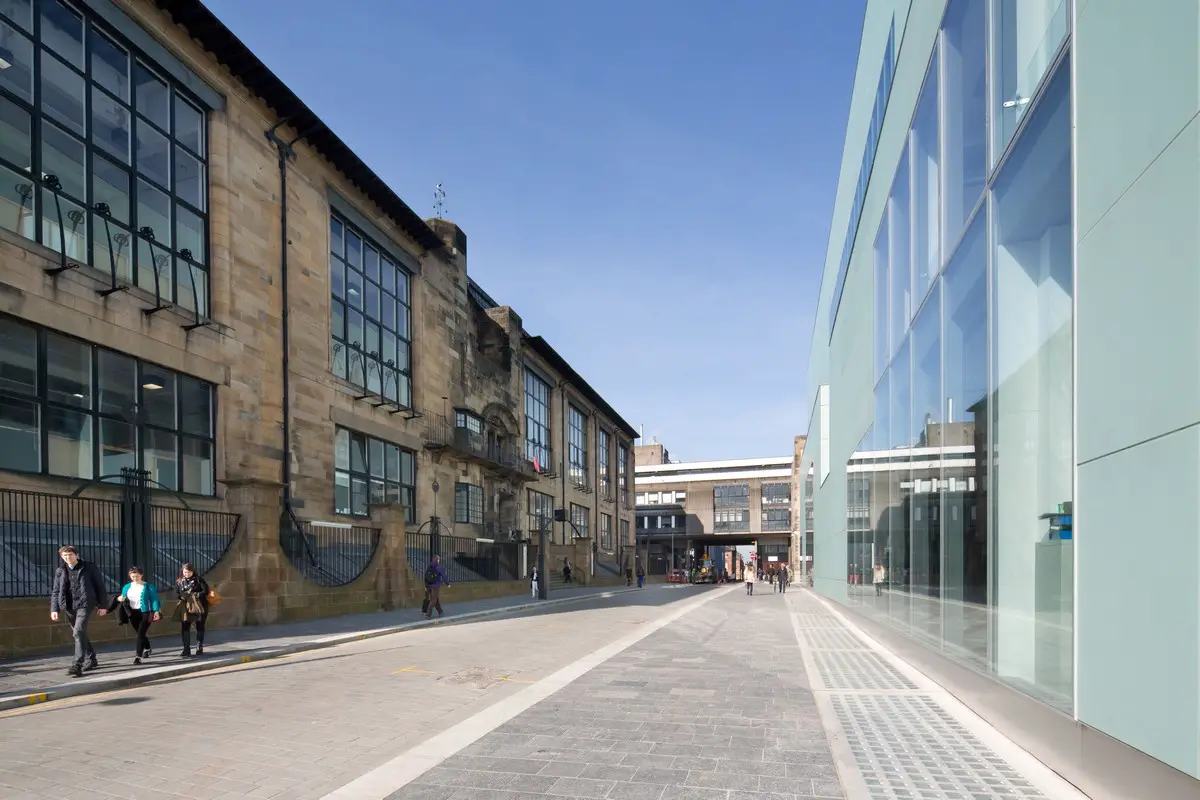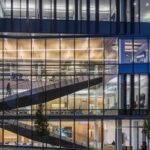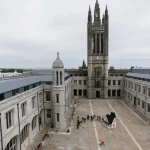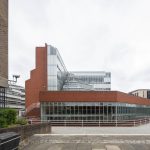Mackintosh Building Glasgow School of Art, 20C Scottish Architecture Photos, SOBC, Architect
Mackintosh Building Options, Glasgow School of Art
22 October 2021
The Glasgow School of Art shares outcome of detailed analysis of options for the Mackintosh Building
The Glasgow School of Art has shared the outcome of a Strategic Outline Business Case (SOBC) for the Mackintosh Project, a rigorous analysis of the options for the Mackintosh Building, today, 22 October 2021. Commissioned by the GSA from external consultants (a hub West-led team including Avison Young) the analysis was undertaken in line with the HM Treasury Green Book guidance and Scottish Public Investment Manual, and involved detailed engagement with stakeholders including representatives of the local community, heritage sector, local and national government and GSA alumni, student and staff.
Debris cleared from within the Mackintosh Building:
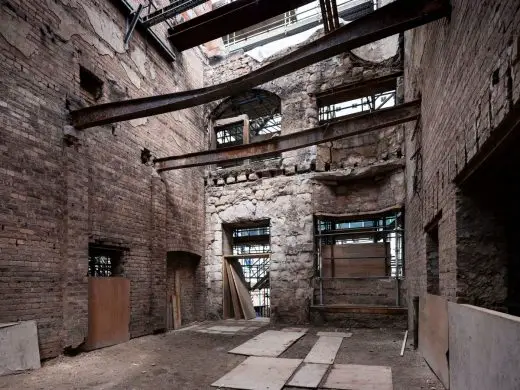
photograph © McAteer
Mackintosh Building, Glasgow School of Art SOBC
One of the key recommendations of the Scottish Government’s Culture Tourism Europe and External Affairs Committee report was that the GSA should consider and consult widely on a range of options before making a final decision on the future of the Mackintosh Building. The GSA is committed to doing this at all stages of the Mackintosh Project.
The Strategic Outline Business Case, the first stage in a comprehensive and structured process, considered a wide range of options for the future of a building which has been core to the academic experience at The Glasgow School of Art as well as being an important community asset and contributor to the cultural and tourism offer in the city. The long list of options ranged from do minimum, a new build on the site or elsewhere on the GSA campus to faithful reinstatement, hybrid, and a building elsewhere in the city. These were analysed and rigorously assessed to create a short list of deliverable options – Faithful Reinstatement, Hybrid and New Build – which were further tested against a “do minimum” option.
The SOBC examined the Strategic, Economic, Commercial, Financial and Management cases alongside sustainability, and the social, cultural and educational impact of each option, within the context of the academic vision for the Mackintosh Project.
Through extensive consultation and robust economic analysis, the SOBC demonstrated that the best option is to undertake a faithful reinstatement within the practical constraints of the regulatory environment, while innovating to make sure that digital technology and sustainability are at the building’s heart. The preferred option addresses the key success factors in each of the areas of the business case and will benefit the nation, students, the community, academia and the economy by delivering the GSA’s academic objectives;
- Enhancing the student experience and consolidating the world-class reputation of a national institution; in a purpose built Art school
- Protecting the nation’s heritage;
- Creating a landmark sustainable building that can act as a catalyst for regeneration of Garnethill and Sauchiehall Street;
- Building community wealth, for example, by developing new apprenticeships in traditional and heritage crafts;
- Growing the GSA’s special contribution to the cultural, creative and economic fortunes of Glasgow;
- Deepening and extending the GSA’s relationships with industry and academia.
The preferred option will now be further considered.
Mackintosh and Reid Buildings (on right, by Steven Holl Architects):
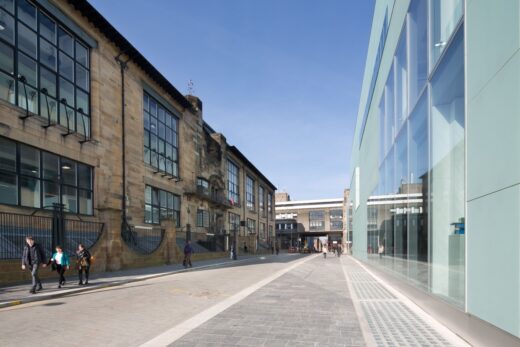
photo © McAteer
Announcing the outcomes of the SOBC Director of The Glasgow School of Art, Professor Penny Macbeth, said;
“The GSA is one of only three UK Art schools to consistently rank in the top ten of the influential QS world rankings for Art and Design. The original Art School building is synonymous with The Glasgow School of Art and it was central to the GSA’s learning, teaching and research for over a century, as well as being an important part of Glasgow’s cultural life and heritage.
“One of the recommendations of the Scottish Government’s Culture Tourism Europe and External Affairs Committee report was that we should examine a range of options for the future of the building, and the Strategic Outline Business Case has done just that, subjecting each of them to a rigorous analysis.”
“Core to the SOBC was a programme of stakeholder engagement and I should like to take this opportunity to thank everyone who took part in this programme including our external Steering Group, led by Professor John French, for their vital contributions and insight. We will continue to work closely with our stakeholders throughout the project.”
The Mackintosh Project Strategic Outline Business Case (SOBC)
The key output from the SOBC is a preferred recommendation that will be taken forward for more detailed evaluation at the OBC stage. This was arrived at through consideration of:
- Strategic Case establishes a close strategic fit between the vision for the future of the Mackintosh Project and the ambitions of the GSA, the community, students, staff, the Scottish and UK Governments, and other statutory bodies. A powerful case is created for a project that will enable the GSA to continue to grow its special contribution to the cultural, creative and economic prosperity of Glasgow and thereby wider Scotland. In doing so, it will protect the GSA’s heritage, create a landmark sustainable, fit for purpose building, catalyse local regeneration and add to the student experience and world-class reputation of the GSA in a global competitive market.
- Economic Case – the Mackintosh Project can be delivered in a variety of ways. However, the extent to which each opportunity meets the GSA’s vision or, indeed, is consistent with the desires of stakeholders or with government policies and guidance, varies considerably. A structured approach to identifying and appraising projects allowed a long list of options to be identified (Do minimum/Faithful reinstatement on site/Hybrid on site/Modern equivalent on site – new build/New build at Stow/Re-commissioning Richmond/Kelly and small new build at Stow/Procure new space in city). These were analysed and filtered to create a short list of deliverable options: – Faithful Reinstatement, Hybrid and New Build which were further tested for value for money. The Economic Case concluded that Faithful Reinstatement provides the greatest overall value for money in Net Present Social Value terms with Hybrid a close second
- Financial Case – A number of high level estimates were applied solely for the purpose of comparing the various options. Specific and detailed costs will be analysed and developed as the project progresses. A variety of funding sources are identified to deliver the capital project and support operation of the new building, including insurance, disposal of assets (buildings), reserves, additional income from increased student numbers, research and other academic activities that would attract funding.
- Commercial Case ensures that a commercial strategy is put in place to deliver a viable procurement and a well-structured contract, by adopting a set of core principles. The strategy covers the procurement of the Design Team through to the operational phase of the new building. The Commercial Case has also identified the diverse range of design services required to deliver the project.
- Management Case confirms that the GSA has established robust and comprehensive management and governance arrangements to effectively and efficiently support the delivery of the Mackintosh Project. The governance arrangements include Mackintosh Project Development Board (chaired by Project Sponsor GSA Director, Professor Penny Macbeth), Mackintosh Steering Group (chaired by Professor John French, a Fellow of Wolfson College Cambridge, who is a leader in sustainable development). The GSA Director of Estates, Eleanor Magennis is Project Director. All of which have clear remits and accountability with the Project Development Board reporting to the Board of Governors via the Business and Estates Committee. See https://themackintoshbuilding.co.uk/project-governance/. This governance structure brings together a wide range of relevant skills, knowledge and expertise and will be augmented by specialist external resources to help develop and deliver the project. Ongoing stakeholder engagement will be a feature of the management of the project along with strong project management, risk management and benefits management arrangements.
Inside the Mackintosh Building after the 2018 fire:
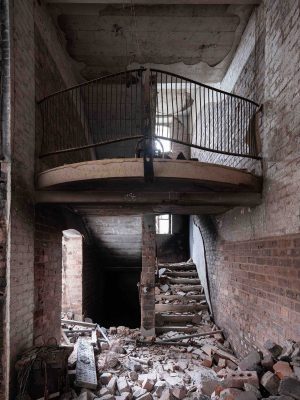
photograph © McAteer
Conclusion
The case for a landmark development that not only reinstates, but builds on, the illustrious heritage of the original Mackintosh building is overwhelming.
Through extensive consultation and robust economic analysis, this preliminary strategic business case demonstrates that the best value option is to undertake a faithful reinstatement, within the practical constraints of the current regulatory environment and whilst innovating to ensure that technology and sustainability are at the building’s heart.
HM Treasury Green Book guidance and Scottish Public Investment Manual
- Strategic Outline Business Case – scoping the scheme (this looks at the strategic context and the need for the development or service, formulates and analyses options, interrogates affordability and deliverability)
- Outline Business Case (OBC) revisits the SOBC focusing in detail on the economic and commercial cases while refining the financial and management cases.
- Full Business Case (FBC) including a detailed plan for delivering the project, managing risks, and realising academic and other benefits prepared prior to the award of any construction contract.
The Mackintosh Building north façade:
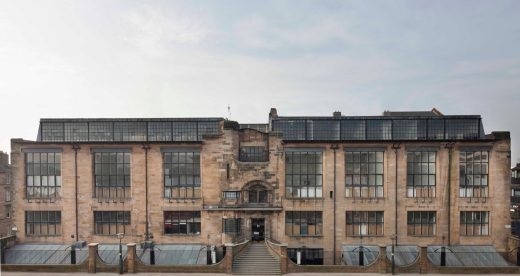
photo © McAteer
The Mackintosh Project
The Mackintosh Project has been established to enable the GSA to plan an effective and appropriately consultative response to the current condition of the Mackintosh Building. It seeks to provide an effective solution to replace those facilities and functions lost as a result of the 2018 fire.
The SOBC is framed with clear governance and reporting arrangements to examine the options and opportunities for the GSA to re-provide academic (and potentially other) facilities, in pursuit of delivering tangible outcomes to its students, researchers, alumni, the local community, economy and other stakeholders – all in the context of the future strategic plan.
Academic Vision for Mackintosh Project
The Glasgow School of Art (GSA) is one of only three UK Art schools to consistently rank in the top ten of the influential QS world rankings for Art and Design. The original Art school building designed by Charles Rennie Mackintosh was a quintessential heritage asset and synonymous with its global brand. Today a landmark development of equal calibre, is required to support GSA in reaching its future ambitions, building on its illustrious past whilst continuing to innovate and reimagine creative practice for the future.
This iconic building will create an environment that will help boost Glasgow’s position as a leading creative and cultural global city, supporting the economy by providing graduates with high level creative, digital and cultural acumen, attributes necessary for the future creative economy.
The Building
The building will be enabled by state-of-the-art digital capabilities, it will be designed and developed using the latest sustainable technologies. Having digital and sustainability at the heart of the offer will provide a new and compelling opportunity for the GSA. Whilst retaining an unequalled approach to creative enquiry, craft and making, the new facility will provide a rare opportunity to bring together the strengths of the GSA, providing both the physical and virtual interrogation of materials, artefacts and ideas. It will provide the GSA with a singular opportunity to interrogate emerging and traditional forms of practice, creative innovation and production within a world leading environment, enabling the School to develop and extend partnerships across the globe.
Convening Power
This will be a building with convening power; it will attract influential figures who will collaborate with the GSA on a range of business, research and enterprise and community-led initiatives. Audience and community engagement will be transformed by the porosity of the space both through the physical and virtual domain. The iconic gallery, library and archive spaces, will enable us to reach new audiences and develop new tools for enquiry led practice, bringing opportunities from the creative, digital and tech sectors for audiences of the future. This in turn will attract investment both in terms of research and innovation funding.
The GSA has sector-leading digital research, teaching and learning expertise in the School of Simulation and Visualisation. When combined with the rapid transformation of the GSA’s curriculum to meet the challenges presented by Covid-19, it means that we are well-placed to be able innovate in the space between digital and analogue enquiry. This places us in a unique position to leverage industry partnerships and research opportunities.
Income Generation
The juxtaposition of approaches that the building offers will enable us to create an additional USP in a competitive market, and help generate new income streams. The approach outlined will support a range of new curriculum and research opportunities enhancing our offer and diversifying income streams, whilst creating a more agile approach to resources.
The strategic growth of the School of Simulation and Visualisation and the School of Innovation will unlock potential within our academic curriculum in new and emerging areas of enquiry. This will provide us with the opportunity to develop a distinctive cross-school offer for all of our students, together with the potential for further collaborative provision, that will support our ambitions to address the key global challenges of the day.
In addition, the development of new models of academic enquiry such as Creative MBA, Degree and M-level Apprenticeships, Executive Education and Taught Doctorates, as well as the expansion of our PhD and post doc offer, will unlock further potential for partnership, and income generation.
Economic Impact
Our position as a world-leading Art School allows us to influence and support important economic imperatives both for Scotland and the UK as a whole. The blend of Art school creativity, innovation, sustainability and digital capabilities will support us in creating a new kind of graduate who can help to catalyse the creative economy and adjacent sectors.
By improving the supply of talent available to the creative industries in order to support growth ambitions in the wider economy. Raising the bar on skills, introducing new pathways into the creative industries and progression routes once working in them to make the sector attractive to a wider and more diverse talent pool.
The next iteration of the Mackintosh Project
The Mackintosh building is an integral part of the Glasgow School of Art’s future, and the Mackintosh project will be bringing a key asset of the School to the fore, linking learning and teaching innovation, with state-of-the-art research and innovation. It is therefore essential that this project and the building are led and managed by the School to ensure the building is fully integrated into and fully harnessed to play its unique role in delivering a world class creative education and student experience for the generations of future GSA students as well as in delivering the wider ambitions of the School.
The GSA believes that the Mackintosh Project has the potential to be a catalyst for the social and economic regeneration of Garnethill and the surrounding commercial areas – in particular Sauchiehall Street. The project should not only be a sensitive response to the Mackintosh Building, but an exemplar of sustainability and a demonstrator project for world-leading place-based, co-designed, community regeneration.
Previously on e-architect:
11 Jun 2013
Glasgow School of Art Building by Architect Steven Holl
Article by Joyce Hwang, an Assistant Professor in the Department of Architecture at University at Buffalo SUNY, NY, USA. She is also Founder of Ants of the Prairie.
Glasgow School of Art Holl Building, Scotland
Design: Steven Holl Architects with jm architects
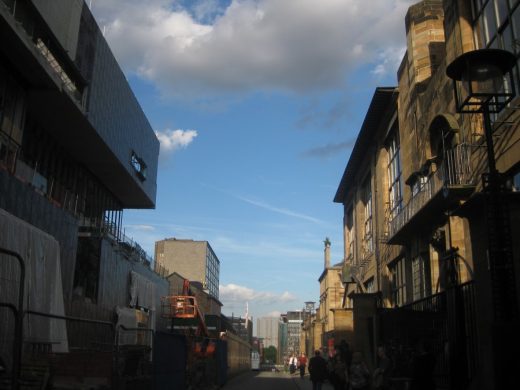
photo © Adrian Welch
Glasgow School of Art Holl Building
International Architectural Designs
Glasgow School of Art Extension Building
Property Articles
Articles on e-architect
Design: AL_A
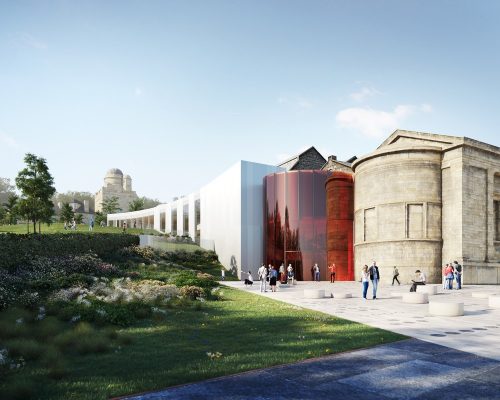
image courtesy of architects office
Paisley Museum Renewal
Pritzker Prize architects – Architect Winners
Comments re Mackintosh Building, Glasgow School of Art welcome

